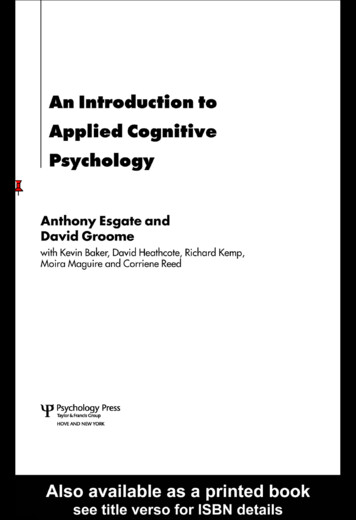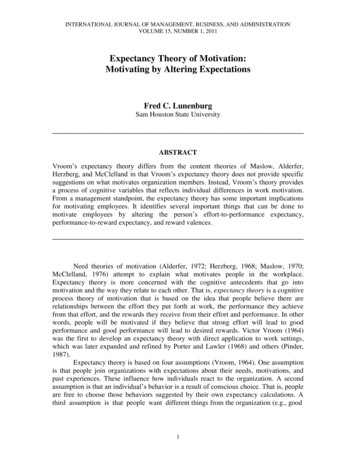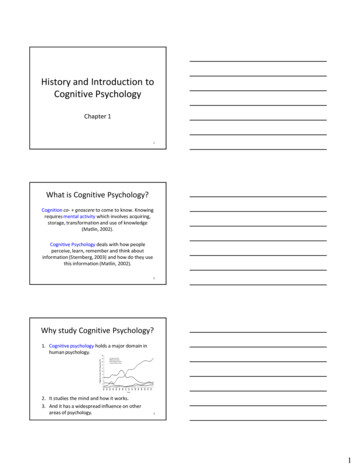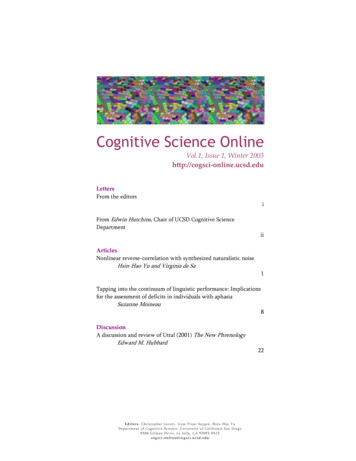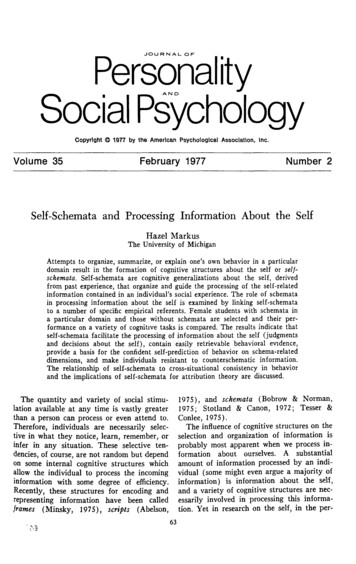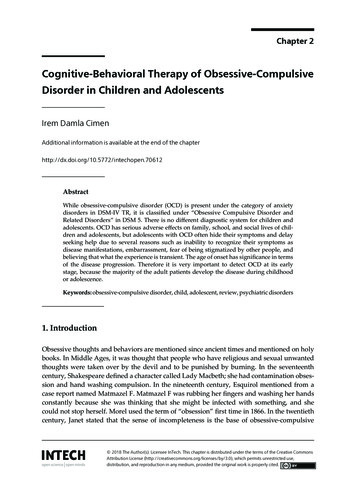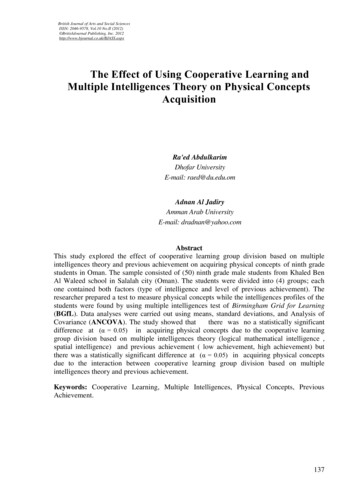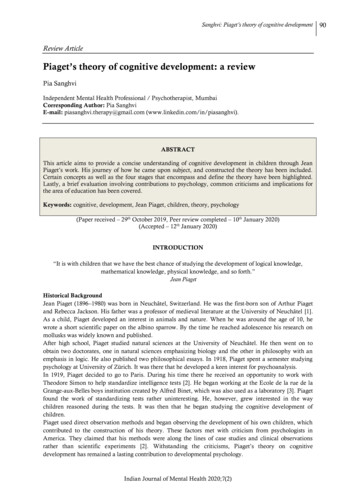
Transcription
Sanghvi: Piaget’s theory of cognitive developmentReview ArticlePiaget’s theory of cognitive development: a reviewPia SanghviIndependent Mental Health Professional / Psychotherapist, MumbaiCorresponding Author: Pia SanghviE-mail: piasanghvi.therapy@gmail.com (www.linkedin.com/in/piasanghvi).ABSTRACTThis article aims to provide a concise understanding of cognitive development in children through JeanPiaget’s work. His journey of how he came upon subject, and constructed the theory has been included.Certain concepts as well as the four stages that encompass and define the theory have been highlighted.Lastly, a brief evaluation involving contributions to psychology, common criticisms and implications forthe area of education has been covered.Keywords: cognitive, development, Jean Piaget, children, theory, psychology(Paper received – 29th October 2019, Peer review completed – 10th January 2020)(Accepted – 12th January 2020)INTRODUCTION“It is with children that we have the best chance of studying the development of logical knowledge,mathematical knowledge, physical knowledge, and so forth.”Jean PiagetHistorical BackgroundJean Piaget (1896–1980) was born in Neuchâtel, Switzerland. He was the first-born son of Arthur Piagetand Rebecca Jackson. His father was a professor of medieval literature at the University of Neuchâtel [1].As a child, Piaget developed an interest in animals and nature. When he was around the age of 10, hewrote a short scientific paper on the albino sparrow. By the time he reached adolescence his research onmollusks was widely known and published.After high school, Piaget studied natural sciences at the University of Neuchâtel. He then went on toobtain two doctorates, one in natural sciences emphasizing biology and the other in philosophy with anemphasis in logic. He also published two philosophical essays. In 1918, Piaget spent a semester studyingpsychology at University of Zürich. It was there that he developed a keen interest for psychoanalysis.In 1919, Piaget decided to go to Paris. During his time there he received an opportunity to work withTheodore Simon to help standardize intelligence tests [2]. He began working at the Ecole de la rue de laGrange-aux-Belles boys institution created by Alfred Binet, which was also used as a laboratory [3]. Piagetfound the work of standardizing tests rather uninteresting. He, however, grew interested in the waychildren reasoned during the tests. It was then that he began studying the cognitive development ofchildren.Piaget used direct observation methods and began observing the development of his own children, whichcontributed to the construction of his theory. These factors met with criticism from psychologists inAmerica. They claimed that his methods were along the lines of case studies and clinical observationsrather than scientific experiments [2]. Withstanding the criticisms, Piaget’s theory on cognitivedevelopment has remained a lasting contribution to developmental psychology.Indian Journal of Mental Health 2020;7(2)90
Sanghvi: Piaget’s theory of cognitive developmentPiaget’s theory is based on four stages or periods. He believed that children progress through the fourstages in a fixed order, at differing rates. Children move from one stage to another when they reach theappropriate maturation level and have been exposed to certain relevant experiences. Piaget suggested thatthe stages do not end abruptly and that transition takes place slowly by merging into the next stage. Heviewed cognitive development as a series of transformations with changes occurring over brief periods [4].It is important to note that he emphasized on observing changes in ‘quality’ of children’s understandingand knowledge rather than quantity.PIAGETIAN CONCEPTSSchemaA schema or scheme is defined as ‘a concept or framework that organizes and interprets information’ [5-6].Piaget described schemas as basic building blocks to understand the world and organize knowledge. Theyare created and developed as and when children interact with their physical and social environments [7].When children are young their schemas are related to sensorimotor or physical activity such as picking upa toy. However, as they start growing their schemas begin to reflect thought and move towards a morecognitive level. Piaget suggested that schemas could be developed through two processes – assimilationand accommodation. These processes are the means through which outside world knowledge can beinternalized.For example, a baby is given a new book. S/he may try to touch it, put it in their mouth, bang it on thefloor or tear pages from it. Through experimentation at the sensorimotor stage, the child is trying toassimilate or accommodate the schema for a ‘book’.AdaptationAdaptation is the child’s tendency to develop and adjust schemas through experimentation and directinteraction with the environment. Adaptation consists of two processes, assimilation and accommodation.During childhood, children are constantly assimilating and accommodating new information in theirschemas.AssimilationAssimilation is the process by which people fit new information into pre-existing concepts or schemas.Wadsworth [8] defines assimilation as ‘the cognitive process by which a person integrates new perceptualmatter or stimulus events into existing schemata or patterns of behavior’ [9].For example, a child sees a peacock for the first time. S/he notices that it has a beak and wings. The childpoints to animal and says, “bird”. S/he has then assimilated the information into their existing schema fora ‘bird’.AccommodationAccommodation is the process by which pre-existing concepts or schemas are restructured to include newinformation. If the new information cannot be altered, a new schema is formed. Wadsworth [8] definedaccommodation as ‘the creation of new schemata or the modification of old schemata’ [9].For example, a child believes that ‘all furry four legged animals are dogs’. S/he then spots a cat and thechild says, "Look a dog!”. When s/he learns that it is in fact a cat and that furry four-legged animals are ofvarious kinds, an accommodation has taken place.Indian Journal of Mental Health 2020;7(2)91
Sanghvi: Piaget’s theory of cognitive developmentSTAGES OF DEVELOPMENTPiaget divided cognitive development into four periods or stages: (1) sensorimotor stage, (2) preoperationalstage, (3) concrete operational stage and (4) formal operational stage. Children progress through each stagein a sequential manner. Each stage is characterized by qualitatively different ways of thinking andcognitive growth. Below is an explanation of all four stages, the approximate ages and majorcharacteristics of cognitive development that are generally observed. A note to clinicians, individualdifferences need to be accounted for while observing the development of children.Sensorimotor Stage (Birth to 2 years)The first stage in Piaget’s theory is the sensorimotor stage, which lasts from birth to approximately 2 yearsof age [4, 10-12]. During this stage infants observe their surroundings using the senses of sight, touch andsound. This stage of cognitive development is divided into six substages [13] –Substage 1: Simple ReflexesThe first substage of the sensorimotor period encompasses of basic reflex actions. This stage begins at birthto the age of 1 month. The infant applies a set of action patterns such as, sucking, biting and grasping.These reflexes become the center of the infant’s cognitive and physical life. It has been found thatassimilation and accommodation begin to take as early as this.For example, when the corner of the baby's mouth is stroked or touched, the baby will turn its head andopen his/her mouth to follow the direction of the stroking. This reflex helps the baby find the breast orbottle while feeding.Substage 2: First habits and primary circular reactionsThis substage occurs from 1 to 4 months of the infants’ life. During this period, infants begin to integratesimple reflex actions by coordinating separate action patterns. The main locus during this period is still theinfant’s own body. Primary circular reactions are schemas that are repeated because they are interesting orpleasurable for the infant. These repetitive, chance reactions help them build cognitive schemes thateventually become habits.For example, Infants may repeat the action of sucking their thumbs or waving their arms and legs.Indian Journal of Mental Health 2020;7(2)92
Sanghvi: Piaget’s theory of cognitive developmentSubstage 3: Secondary circular reactionsIn the third substage the baby’s interest of the environment increases. This period occurs from 4 to 8months of age. Piaget called these schemes ‘secondary circular reactions’ because the focus of attentiontends to shift away from ones own self to the external world.For example, the child may pick up a rattle and keep shaking it.Substage 4: Coordination of secondary circular reactionsThis substage lasts from 8 to 12 months. During this period the beginning of goal-directed behavior isobserved. Infants coordinate and combine certain schemas to execute an action. The child starts tounderstand the difference between a means and an end (cause and effect). This leads to the developmentand achievement of object permanence. Object permanence refers to ‘the realization that people andobjects exist even when they cannot be seen’ [13].For example, the child will move an object out of the way to reach for another.Substage 5: Tertiary circular reactionsBeginning at 12 months, this substage continues till the child is 18 months of age. In this substage theinfant carries out mini experiments to learn about the environment. They become fascinated with theproperties of an object and experiment with new behavior. Through these experiments, schemas arealtered and adapted. Children begin to solve problems using the trial-and-error method.For example, an infant may experiment by dropping his/her toy or food onto the floor from a high chair tosee the effect that it had.Substage 6: Beginnings of thoughtThis substage is characterized by the beginning of insight and creativity. This stage occurs from 18 monthsto 2 years. The major achievement of this stage is the capacity for mental representations. Majorcharacteristics observed during this period are make-believe activity, complex schematic understanding,acceptance of others but with focus on self and internalization of images or past events.For example, the child’s play begins to involve imaginary creatures.Preoperational StageIn the preoperational stage the child’s use of symbolic thinking grows. This period occurs when the child is2 to 7 years old. During this stage the child begins to form mental representations of events and ideas.They are also able to communicate using words, gestures and symbols. For example: The child may seehis/her mother holding a pair of shoes which may prompt the question, “We go out?’. In this mannerchildren rely less on sensorimotor activity and more on mental representations to understand the worldaround them. Key aspects of this stage include – Conservation: The child’s understanding that a certain quantity will remain the same despitechange in arrangement or physical appearance. For example: A child is shown two glasses ofwater, one short and the other tall. The short, broad glass is filled with water. The same amount ofwater is then transferred from the short glass to the tall, thin glass. The child is asked whetherthere is more water in the second glass. If the child has mastered the concept of conversation s/hewill answer saying, ‘No’.Indian Journal of Mental Health 2020;7(2)93
Sanghvi: Piaget’s theory of cognitive development Centration: The tendency to focus on one aspect of a stimulus. Children make judgments basedon the most outstanding feature or aspect in their perceptual array of sight. For example: A childis shown two arrangements of circles. One is clustered together in a symmetrical arrangementwhile the other is slightly spaced out. The child is then asked to point to the row that containsmore circles. S/he will end up focusing on the superficial aspect of arrangement i.e. appearancerather than the quantity and point to the spaced-out arrangement. Egocentricism: The child’s inability to see the world from another’s perspective. Egocentricthought refers to thinking that does not take into account the views of others. One way tounderstand this concept is Piaget’s’ three-mountains task. A child was presented with a threedimensional model containing three mountains. They looked at the model from one perspective(e.g. Location A) while a doll was placed in another location (e.g. Location B). The doll’sperspective was different from that of the child’s. The child was asked to choose the dolls point ofview (literally). Most children stated that the doll’s view was the same as what they could see. Letus discuss egocentric thought using an example. A child assumes that since s/he has an elderbrother therefore s/he is a younger sibling. In turn s/he believes that all his classmates have eldersiblings. It should be noted that this process is not the same as selfishness, it is a part of the naturalcourse of development and is not a lasting pattern of behavior.Concrete Operational StageThe concrete operational stage occurs between ages 7 and 11 or 12. This stage is characterized by logicaloperations. The main change during this stage is that the child’s thinking becomes less dependent onperception and more focused on logic. Children are better able to understand conservation tasks in thisperiod. They are able to focus on multiple aspects of a stimulus, an ability known as ‘decentering’. Onceconcrete operations begin taking hold, children grasp the concept of ‘reversibility’. Reversibility is thenotion that transformations of a stimulus can be reversed. For example, the children learn that a ball ofclay that is turned into a long, thin rope can return to the shape of a ball again.Formal Operational StageChildren enter the formal operational stage at the age of 11 or 12. During this stage the young adolescentlearns how to think abstractly. A major element of this stage includes the ability to reason. Adolescentslearn the concepts of deductive and inductive reasoning and apply their knowledge by solving problemsand conducting experiments. The pendulum problem is often used to describe the reasoning ability at thisstage. For example: An adolescent is shown a pendulum. S/he is then asked to determine factors that areresponsible for the movement of the pendulum. The option to alter the length of the string, amount offorce, weight, and height is given to the participant. The child will then form and test a series of hypothesesto come to a conclusion.CONTRIBUTIONS OF PIAGET’S THEORY Piaget’s work on cognitive development has remained a contribution to the areas of child anddevelopmental psychology. His theory was one of the first to explain and describe the process ofchild development.Indian Journal of Mental Health 2020;7(2)94
Sanghvi: Piaget’s theory of cognitive development The theory is studied and applied by various researchers even today. Furthermore, applications tothe fields of engineering, education, therapy and other such areas have been explored.Piaget was a great reporter of children’s behaviors. He provided detailed descriptions of theircognitive abilities. He introduced useful concepts to cognitive psychology such as schemas, objectpermanence, egocentricism etc.Piaget’s questions on cognitive development lead thousands of researchers to study the area.Hence, a large amount of research exists that helps us understand children and their cognitivegrowth.CRITICISMS Piaget assumed that those children who were unable to perform various cognitive tasks lacked theunderlying cognitive structure. This assumption is not valid as there are various factors that canaffect a child’s performance. Piagets tendency to equate task performance with competency hasbeen criticized.Even though Piaget mentioned that cultural factors influence the growth of cognition, he devotedlittle attention to social and cultural influences. He also did not take into account how childrendevelop through social interactions.Piaget provides a vague explanation of cognitive growth. He has been criticized for using abstractterms and pairing them with difficult tasks. Researchers now look upon his theory as an elaboratedescription of cognitive development that has limited explanatory power [14].Piaget maintained that cognitive development occurs in stages, which are holistic structures.Many have challenged this assumption of holistic structures. They also questioned whethercognitive growth does in fact take place in sequential stages.IMPLICATIONS FOR EDUCATION Teachers can individualize learning experiences based on the child’s stage of cognitivedevelopment.Children can be encouraged to experiment the various hypotheses and ideas that they form inorder to come up with their own conclusions and opinions.Learning can be perceived as restructuring and constantly adapting cognition.Methods to enhance cognitive development through experiential learning can be mith L. A brief biography of Jean Piaget. Jean Piaget Society: Society for the Study of Knowledge andDissemination, 2000.Fleming J. Piaget and cognitive development. PhD Master Thesis. 2004.Lascarides VC, Hinitz BF. History of early childhood education. Routledge; 2013.Bjorklund DF. Behavioral Epigenetics: The Last Nail in the Coffin of Genetic Determinism. Human Dev2018;61(1):54-9.Piek JP. Infant motor development. Human Kinetics; 2006.Marszalek JF, Myers JE. Dream interpretation: A developmental counseling and therapy approach. J MentHealth Couns 2006;28(1):18-30.Cahan ED. The genetic psychologies of James Mark Baldwin and Jean Piaget. Dev Psychol 1984;20(1):12850.Wadsworth BJ. Piaget's theory of cognitive development: An introduction for students of psychology andeducation. McKay; 1971.Ginsburg HP, Opper S. Piaget's theory of intellectual development. Prentice-Hall, Inc; 1988.Gallagher JM, Reid DK. The learning theory of Piaget and Inhelder. iUniverse; 2002.Müller U, Carpendale JI, Smith L, editors. The Cambridge companion to Piaget. Cambridge UniversityPress; 2009.Singer DG, Revenson TA. A Piaget primer: How a child thinks. International Universities Press, Inc. 1997.Brainerd CJ. Piaget's theory of intelligence. Prentice Hall; 1978.Indian Journal of Mental Health 2020;7(2)95
Sanghvi: Piaget’s theory of cognitive development14. Carey WB, Crocker AC, Elias ER, Feldman HM, Coleman WL. Developmental-Behavioral Pediatrics EBook. Elsevier Health Sciences; 2009.15. Shaffer DD, Kipp K. Developmental psychology: Childhood & adolescence: Childhood and adolescence.Cengage Learning; gements – NilConflict of Interest – NilFunding – NilIndian Journal of Mental Health 2020;7(2)96
assimilate or accommodate the schema for a ‘book’. Adaptation Adaptation is the child’s tendency to develop and adjust schemas through experimentation and direct interaction with the environment. Adaptation c
